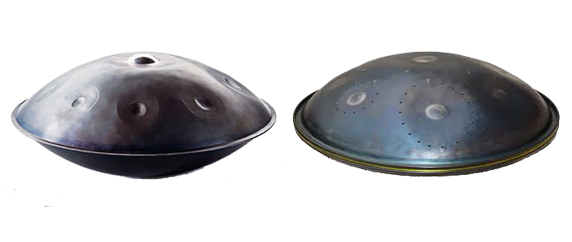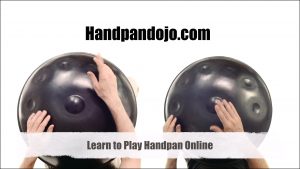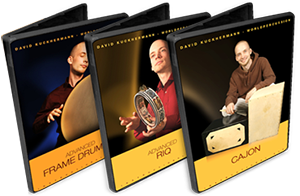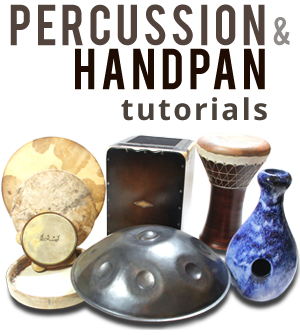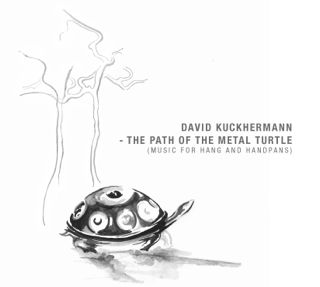the PanArt Hang (drum) and Handpans
the PanArt Hang (drum) and related handpans
the instrument family of handpans is relatively young.
The PanArt Hang was invented in 2000 in Bern, Switzerland by Felix Rohner and Sabina Schärer. It is related to the Steeldrum from Trinidad and the word “Hang” means “hand” in Berndeutsch. As the name suggests, the hang is usually played with the hands and fingers. It has a central note which is called the “Ding” and there are 7 or 8 tone circles around it.
The bottom side of the Hang is called the “Gu” side, and it can be played in a percussive way, similar to an Udu, or Ghatam drum.
Although the term “hang drum” is frequently used, according to the makers, the hang is not any kind of drum or hand drum. One reason for this distinction is the fact that when hit too hard, the hang can easily detune. So if you have one, better play your instrument gently.
Scales of the PanArt Hang:
For the first generation of the hang there were many different tunings available which were inspired by a variety of ethnic and historical scales. In the later generations the number of available tunings was reduced and the overall tonal range of the instrument was lowered. For the last generations, the “Integral” and “Free Integral” hanghang (plural of hang), the Central Note, the Ding, is at D3 and the 7 notes around are A3, Bb3, C4, D4, E4, F4, and A4. Since 2010 the instrument is not tuned with electronic tuner any more, but intuitively by ear. This generation leaves the well-tempered tuning and is called “free integral hang”.
The hang inspired instrument makers from around the world and the instrument family of handpans was created.
In the following video you can see Hang of all the different generations and examples of most of the currently build hardpans.
Hang and Handpan Comparison video:
1st generation Aeolian Hang:
Integral Hang, played by Ward van Oeteren:
Free Integral Hang:
Some other members of the handpan family:
The Halo
is build by Pantheon Steel in St. Louis, USA. There is a lower model (Genesis), a medium (Cirrus) and a higher one (Stratus) and a couple of different tunings are available each year. If you are interested in a Halo, you can sign up for the lottery on the Pantheon Steel website. If you win the lottery, you can buy a Halo in the coming year.
http://www.pantheonsteel.com/
Halo Genesis, Golden Gate Tuning:
Halo Cirrus, Daxala Tuning, played by Kyle Cox:
Halo Stratus, Oxalis Tuning, played by Lauri Wuolio:
BellArt Bells
are built in Spain and in shape close to the original hang. The waiting list is currently closed and several years long.
http://bellart.es/
Colin Foulke on a Bells Magic Hour:
The Spacedrum
is built in France and only has a 4 months waiting list. It doesn’t use the concept of a central dome for the Ding, that most other handpans use. Waiting list is currently about 4 months.
http://spacedrum.fr/
Custom Spacedrum (Steve Shehan tuning) played by Nadishana:
The Caisa
is built in Germany and there are more than a dozen different tunings available. If I’m not mistaken, the waiting time at the moment is about 9 months to a year.
http://www.caisa-music.com
C-Pentatonic Caisa, played by Klaus Rädisch- Shoin
The SpB (inofficial name)
is made in Russia and one of the younger members of the instrument family. There is no official price or waiting list, but you can find examples on youtube.
9-note SpB in F Integral Tuning:
The Bali Steel
is made in Indonesia. Several different tunings are available and the last time I checked, the waiting time was about a year.
http://www.balisteelpan.com
Bali Steel in Hijaz Tuning:
How to buy a hang (drum) from PanArt:
The first question that many people have is “how can I get one of these?”
If you are looking to get an original PanArt hang, it is available from the makers in Switzerland. There are certain steps involved and if you are offered the chance to buy one, you have to travel to Switzerland to personally choose the instrument. You can find more information on http://www.hangblog.org.
How to buy one of the other handpans:
Generally in the field of handpans, the demand is much higher than the number of available instruments.
Each maker has a different philosophy how to choose his customers. A good place to find information about the different instruments is the handpan forum at http://www.handpan.org.
For more information on the original PanArt Hang, other handpans and related hang-inspired instruments, check out the links below.
handpan.org
hang-music.org
wikipedia Hang article
pantheonsteel.com
bellart.es
spacedrum.fr
www.balisteelpan.com
www.caisa-music.com
If you’re interested to learn playing:
check out my instructional videos.
some other interesting hang and handpan – related videos:
David Kuckhermann and Nadishana – Duet on a Hang, a spacedrum and two SpBs:
an all-time classic – Manu Delago’s “Mono Desire”
disclaimer: Some of the definitions and names on this page (like the name handpan) are controversial.
According to PanArt, the hang is not a handpan, and it is important to them and other makers, that these instruments are no drums.
If you want to get more in-depth information about the instruments and all the different angles and opinions around them, check out the links above.
And if you don’t agree with my view or my use of the hang, that’s ok. Just don’t take it personal ;).


